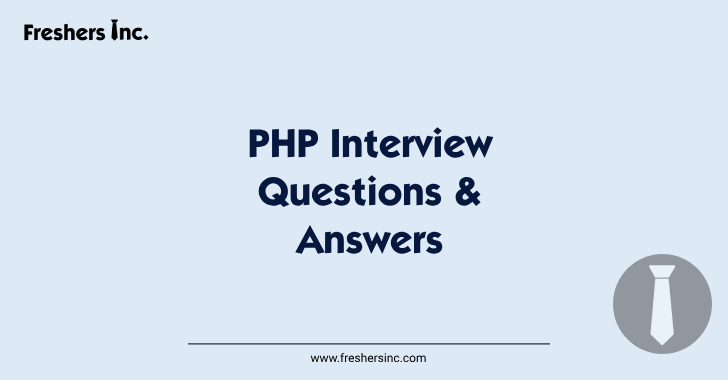PHP is a server-side scripting language, commonly used in the arena of web development, known for its cross-platform versatility and efficiency. Top companies such as Facebook, WordPress, Slack, Wikipedia, MailChimp, and more use PHP for its powerful features and performance.
Here are the Top 20+ PHP Interview Questions 2025 for freshers & experienced professionals (3, 5, 8 Years) that you need to have a look.

What is PHP?
PHP is the foundation programming language for designing a website or web application. It is a server-side scripting language with HTML to create Static website, Dynamic website or Web application. PHP was created by Rasmus Lerdorf in 1994.
Server-side language: PHP runs server-side and creates HTML or other content that is sent to the client-side browser.
Create dynamic content: This is another feature that makes PHP stand out PHP can connect to databases and can process user input, making websites interactive and data-driven.
Compatible with Windows, Linux, and macOS: It is cross-platform.
Interfacing with Databases: PHP is highly compatible with databases such as MySQL, making it perfect for developing dynamic, database-driven sites.
Open-Source: PHP is free to use, and has a large community of developers behind it.
PHP Redirect Page: How to Redirect a Page using PHP
Redirecting a user to another page using header() in PHP This function simply sends a raw http header to the browser to tell it to navigate to a different URL.
header(“Location: newpage. php”);
exit();
Is PHP a case sensitive language?
Answer: PHP is case-sensitive for variables but not for function names, class names and constants.
What is the use of PHP in handling a form data?
There are two main superglobal PHP variables that we use to handle form data in PHP: $_GET and $_POST.
Using $_GET to collect form data that is transmitted in the form of a URL (generally from a query string) This is often the case with search forms or when you want the data to be visible in the URL.
$_POST – Used to collect form data sent with the HTTP POST method, which is considered a more secure way of sending data, as the data is not shown in a URL. It is generally used for sensitive data such as login credentials or when data is being submitted in large quantities.
What is the full form of PHP?
PHP stands for Hypertext Preprocessor and it was known as Personal Home Page in the earlier versions.
What was the old name of PHP?
PHP stands for Personal Home Page — which was its original name.
What are the uses of PHP?
PHP is one of the most commonly used languages in web development for a range of tasks. Some of its key uses include:
It is a server-side script language for creating dynamic websites or web apps.
It gets data from forms to display the dynamic content of the page.
It will allow you to work with database, sessions, send and received cookies, send emails etc.
Which means, it can be used to insert, delete and add entries within the database.
A restriction can be set to the user for the permission to use the web page.
What is PEAR in PHP?
PEAR(PHP Extension and Application Repository) provides a framework as well as a distribution system for reusable PHP components. It is short for PHP Extension and Application Repository. It has PHP snippets and provides a library to reuse code. It is command-line interface for package installation.
Highlighting the key features of PEAR
Reusable Code
Package Management
Standardization
Autoloading
Command-line Interface (CLI)
Web-based Interface
Static vs Dynamic Websites: What is the Difference
Static Website: Content is constant and only changed when developer manually updates it. Static Websites : is made of HTML, CSS and JavaScript; there is a separate file for each page
Little personalization for the user; all visitors receive identical content.
Increased speed as it only serves pre-built content as it is.
But it’s easier to update; if you wanna change something on the news, you just need to update community-posts. Json does It for you.
Less expensive to build and host, generally.
Dynamic Website: Content is created on the fly and is usually determined by user interaction or a database query. Developed with server-side technologies like PHP, ASP. NET, or Node. Based on javascript and can use the database to get the content.
Content that may be altered as the end user interacts with it (for example, login systems, product catalogs)
Loading Time: Might be delayed for real-time content generation and database queries
Involves database updates and backend management, which can be complicated.
Might be costlier because it requires server-side scripting and database support.
Using a Valid Name For Variable In PHP
The next two rules are rules which must be followed when naming variables in php.
In PHP, a variable name starts with the dollar sign ($) followed by the variable name. For example, $price=100; Where price is a variable name.
Variable can only start with letter (a-z, A-Z) or underscore (_)
Variable names can include letters, numbers, underscores but can not use special characters such as +, -, %, &, … etc.
PHP variable names cannot be included a space.
PHP is case-sensitive, which means that $NAME and $name are two different variables.
But how do you run a PHP script from the command line?
We will mention below the following PHP command line to run the PHP program.
Open terminal or command line window.
Navigate to Folder → To Folder/Directory that has the PHP files.
We can you PHP code and run it with command php file_name. php
Use the command to start the server for testing sqm51 at port in php code: php -S localhost:port -t your_folder/
How to Hash Passwords in PHP : the most common approach
The crypt() is the second PHP built-in function used to hash passwords, with support for various hashing algorithms (SHA-1, SHA-256, MD5, etc.). Although these algorithms are praised for their speed and efficiency, they have fallen out of favor for hashing passwords simply because they can be brute-forced or rainbow-tabled.
How JavaScript is communicating with PHP?
Yes, JavaScript is able to communicate with PHP mostly on AJAX (Asynchronous JavaScript and XML) JavaScript makes requests on the server via PHP, the requests are processed and data (in many cases Json or HTML) is returned to JavaScript to manipulate the page in the browser without page reloading.
Common use cases include
How to create an AJAX-like behavior to submit the forms without refreshing the entire page.
Dynamicaly fetching data from a server.
Changing the content inside a page, based on user actions.
Describe the different types of errors.
There are three basic types of errors in PHP:
Notices — this type of error is used to describe a non-critical error that, while the script can continue, it is indicative something went wrong. These are hidden from the view of users. For instance, referring to an undefined variable.
Warnings: More serious than notices. The first important difference is that warnings are non-interruptive. This is by default, the user can see it. For example: include a non-existent file
Fatal: This is the highest level of error which, if occurred, causes the execution of the script to die immediately. For instance, trying to get a key from a null object or require() a file which doesn’t exist.
But how do you set the constant in PHP?
The define() function is a core part of PHP Defining Constants.
It helps to declare and access the value of a constant, a name for a permanent value during the life of a script.
Constants differ from variables in that the dollar sign ($) is not used when you define them, and constants cannot be changed once they are declared and cannot be undefined.
Typically, you use constants to store a static value, such as a domain name (e.g. www. geeksforgeeks. org).
Some of the most popular frameworks in PHP?
Here are some of the popular PHP frameworks:
- Laravel
- CodeIgniter
- Symfony
- CakePHP
- Yii
- Zend Framework
- Phalcon
- FuelPHP
- PHPixie
- Slim
Which are the best PHP Content Management Systems (CMS)?
Examples of widely-used Content Management Systems (CMS) and Built on PHP:
WordPress : WordPress is a free-to-use and open-source Content Management System (CMS) framework. It is the latest most commonly used CMS framework.
Joomla — It is a free and open-source CMS for publishing web content. It is built in the the independent model-view-controller web application framework.
Magento : It is an open-source and e-commerce platform to develop an online business.
Drupal — A PHP-developed Content Management System (CMS) platform under GNU (General Public License)
What does break and continue do in a statement?
Similar to if, break and continue could be used in loops and switch statements to control the flow of execution.
break: Break statement is used to break the entire iteration of any loop immediately and control of program is transferred to the next statement after loop.
continue:The continue statement will skip the current iteration and bring the next iteration early. Case and continue 2 are terminators for case; continue 2 skips the iteration of the loop you are currently in.
How are we to use count() function in PHP?
This will simply count how many elements are there in the array using PHP count() method. And since we set the variable we want to check to the empty array, the function will probably return 0. The variable not set, again the function will return 0.
What are the different kind of loop in PHP?
PHP provides four varieties of loop that are given underneath:
- for loop
- while loop
- do-while loop
- foreach loop
Explain what is Parser in PHP??
A PHP parser is a software that translates PHP code into a machine-readable format suitable for execution. It converts the PHP statements to the machine language that the server uses to process and run the script. you can use the builtin token_get_all() function to parse PHP code to get token array with a list of arrays representing parts of the PHP code. (variables, keywords, operators and so on)

